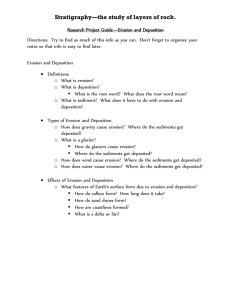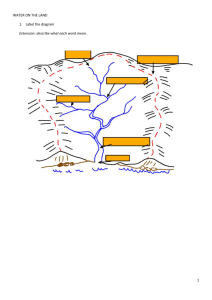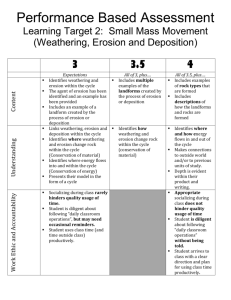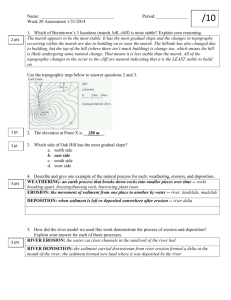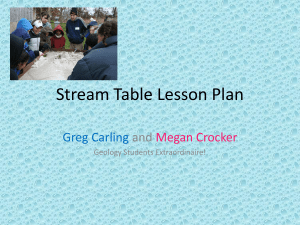seim.unit.5E3
advertisement
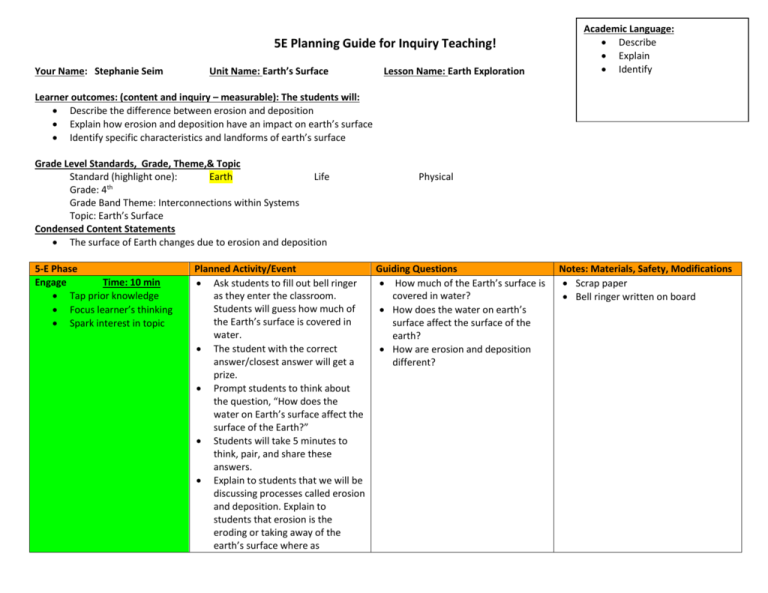
5E Planning Guide for Inquiry Teaching! Your Name: Stephanie Seim Unit Name: Earth’s Surface Lesson Name: Earth Exploration Academic Language: Describe Explain Identify Learner outcomes: (content and inquiry – measurable): The students will: Describe the difference between erosion and deposition Explain how erosion and deposition have an impact on earth’s surface Identify specific characteristics and landforms of earth’s surface Grade Level Standards, Grade, Theme,& Topic Standard (highlight one): Earth Life Grade: 4th Grade Band Theme: Interconnections within Systems Topic: Earth’s Surface Condensed Content Statements The surface of Earth changes due to erosion and deposition 5-E Phase Engage Time: 10 min Tap prior knowledge Focus learner’s thinking Spark interest in topic Planned Activity/Event Ask students to fill out bell ringer as they enter the classroom. Students will guess how much of the Earth’s surface is covered in water. The student with the correct answer/closest answer will get a prize. Prompt students to think about the question, “How does the water on Earth’s surface affect the surface of the Earth?” Students will take 5 minutes to think, pair, and share these answers. Explain to students that we will be discussing processes called erosion and deposition. Explain to students that erosion is the eroding or taking away of the earth’s surface where as Physical Guiding Questions How much of the Earth’s surface is covered in water? How does the water on earth’s surface affect the surface of the earth? How are erosion and deposition different? Notes: Materials, Safety, Modifications Scrap paper Bell ringer written on board Explore Time: 80 min Provide learners with common, concrete, tactile experiences with skills and concepts Observe and listen to students Ask probing questions Act as a consultant Explain Time: 20 min Encourage students to deposition is the opposite. It is taking earth’s materials away from one area and taking them to build up another area. Inform students that we will be investigating with erosion and deposition. We will be conducting an experience that will allow us to see how erosion and deposition work through the use of water. Remind students that water takes up most of the earth’s surface so when dealing with erosion and deposition, water is the most powerful agent. Allow students 40 minutes to conduct the erosion experiment, materials are prepared for students, students just need to set up the experiment and perform the experiment. Debrief with students to discuss erosion and how it works. Allow 40 minutes for students to conduct the deposition experiment. Students will be required to set up the experiment just as they set up the erosion stream tables. Students will again collaborate and discuss the results of the experiment. As students complete the deposition stream table, instruct them to do the vial shake up activity. Once students are finished with their experiments, debrief with What does erosion look like in a real world experiment? How is water used to deposit materials in a new location? How does the erosion process that we experienced in the stream table relate to the Grand Canyon? How are the stream tables like the picture of the Grand Canyon? What happened to the earth material that once filled the area that is now the canyon? Did you find the sand and the diatomaceous earth in the same place? Why or why not? How do the results of the shake test explain why the sand and diatomaceous earth were deposited in different places in your stream table? Stream table experiment materials for erosion and deposition Vial shake up activity Stream table set up sheet Landform vocabulary sheet Activity Sheet for both experiments Image of the Grand Canyon Guided Questions: Where did erosion occur in your Activity sheet explain concepts in their own words Ask for justification Use students previous experiences as the basis or explaining concepts Clarify and correct misconceptions Extend Time: 30 min Apply same concepts and skills in a new context resulting in deeper and broader understanding Encourage the students to apply the concepts/skills to new situations Evaluate Time:10 min Observe as students apply new concepts and skills Assess, formally and/or informally student progress toward achieving the learner outcomes students by holding a classroom discussion on what their group’s findings were. Allow students to explain what they saw. Prompt students with guided questions. Allow students time to ask questions if they need clarity. Ask students to explain similarities and differences within each experiment. It is extremely important for students to understand the difference between deposition and erosion. Handout out ESS Vocabulary Chart to every student. Give students 15 minutes to complete their chart. Students should apply the concepts they learned in the experiments to help them better explain the vocabulary words. Students will turn in their vocabulary chart to be graded for accuracy. Once students have finished their vocabulary charts. Pull up online resource videos of deposition and erosion. This will allow students to see the processes happening in their everyday environment. Observe students understand of the material throughout the experiments. Give students a comprehension quiz that will allow students to demonstrate their understanding of the ideas they learned stream table? Where did deposition occur in your stream table? Where do you think the material that eroded out of the Grand Canyon ended up? What did you learn about the flow of water by adding food coloring? How were your stream tables like the picture of the Grand Canyon? Give a definition, example, picture, and a sentence explaining your vocabulary words. How does deposition and erosion occur in our everyday lives? ESS Vocabulary Chart Describe what erosion is. Give an example of erosion. Describe what deposition is. Give an example of deposition. Give an example of where either erosion or deposition has occurred in the world. Comprehension Quiz Assess students’ knowledge and/or skills Allow students to assess their own learning and group process skills throughout the deposition and erosion experiments.




